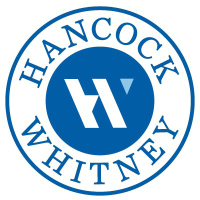Company Analysis Hancock Whitney Corporation
1. Summary
Advantages
- Dividends (2.53%) are higher than the sector average (1.72%).
- The stock's return over the last year (23.27%) is higher than the sector average (-26.38%).
- Current debt level 3.97% is below 100% and has decreased over 5 years from 8.87%.
- The company's current efficiency (ROE=10.32%) is higher than the sector average (ROE=5.61%)
Disadvantages
- Price (54.6 $) is higher than fair price (54.42 $)
Similar companies
2. Share price and performance
2.1. Share price
2.2. News
2.3. Market efficiency
| Hancock Whitney Corporation | Financials | Index | |
|---|---|---|---|
| 7 days | -0.2% | 0.4% | -0% |
| 90 days | 11.1% | -32.9% | 2.4% |
| 1 year | 23.3% | -26.4% | 22.4% |
HWC vs Sector: Hancock Whitney Corporation has outperformed the "Financials" sector by 49.65% over the past year.
HWC vs Market: Hancock Whitney Corporation has outperformed the market by 0.8759% over the past year.
Stable price: HWC is not significantly more volatile than the rest of the market on "NASDAQ" over the last 3 months, with typical variations of +/- 5% per week.
Long period: HWC with weekly volatility of 0.4474% over the past year.
3. Summary of the report
4. Fundamental Analysis
4.1. Stock price and price forecast
Above fair price: The current price (54.6 $) is higher than the fair price (54.42 $).
Price is higher than fair: The current price (54.6 $) is 0.3% higher than the fair price.
4.2. P/E
P/E vs Sector: The company's P/E (10.62) is lower than that of the sector as a whole (38.91).
P/E vs Market: The company's P/E (10.62) is lower than that of the market as a whole (49.04).
4.2.1 P/E Similar companies
4.3. P/BV
P/BV vs Sector: The company's P/BV (1.1) is higher than that of the sector as a whole (0.6287).
P/BV vs Market: The company's P/BV (1.1) is lower than that of the market as a whole (3.17).
4.3.1 P/BV Similar companies
4.4. P/S
P/S vs Sector: The company's P/S indicator (2.21) is lower than that of the sector as a whole (4.98).
P/S vs Market: The company's P/S indicator (2.21) is lower than that of the market as a whole (10.24).
4.4.1 P/S Similar companies
4.5. EV/Ebitda
EV/Ebitda vs Sector: The company's EV/Ebitda (106.47) is higher than that of the sector as a whole (40.84).
EV/Ebitda vs Market: The company's EV/Ebitda (106.47) is higher than that of the market as a whole (28.32).
5. Profitability
5.1. Profitability and revenue
5.2. Earnings per share - EPS
5.3. Past profitability Net Income
Yield Trend: Negative and has fallen by -193.82% over the last 5 years.
Accelerating profitability: The return for the last year (0%) exceeds the average return for 5 years (-193.82%).
Profitability vs Sector: The return for the last year (0%) exceeds the return for the sector (-15.99%).
5.4. ROE
ROE vs Sector: The company's ROE (10.32%) is higher than that of the sector as a whole (5.61%).
ROE vs Market: The company's ROE (10.32%) is lower than that of the market as a whole (10.71%).
5.5. ROA
ROA vs Sector: The company's ROA (1.1%) is lower than that of the sector as a whole (5.48%).
ROA vs Market: The company's ROA (1.1%) is lower than that of the market as a whole (6.47%).
5.6. ROIC
ROIC vs Sector: The company's ROIC (0%) is lower than that of the sector as a whole (5.05%).
ROIC vs Market: The company's ROIC (0%) is lower than that of the market as a whole (10.79%).
7. Dividends
7.1. Dividend yield vs Market
High yield: The dividend yield of the company 2.53% is higher than the average for the sector '1.72%.
7.2. Stability and increase in payments
Dividend stability: The company's dividend yield 2.53% has been steadily paid over the past 7 years, DSI=0.93.
Weak dividend growth: The company's dividend yield 2.53% has been growing weakly or stagnant over the past 5 years. Growth over only 2 years.
7.3. Payout percentage
Dividend Coverage: Current payments from income (26.67%) are at a comfortable level.
8. Insider trades
8.1. Insider trading
Insider Buying Exceeds insider sales by 100% over the last 3 months.
8.2. Latest transactions
| Transaction date | Insider | Type | Price | Volume | Quantity |
|---|---|---|---|---|---|
| 29.10.2024 | PICKERING CHRISTINE L Director |
Sale | 52.4 | 39 981 | 763 |
| 21.10.2024 | Wilkins Carleton Richard Director |
Sale | 50.95 | 40 760 | 800 |
| 18.10.2024 | Achary Michael M Chief Financial Officer |
Sale | 52.55 | 443 049 | 8 431 |
| 29.07.2024 | BERTUCCI FRANK E Director |
Sale | 57.03 | 117 083 | 2 053 |
Pay for your subscription
More functionality and data for company and portfolio analysis is available by subscription




